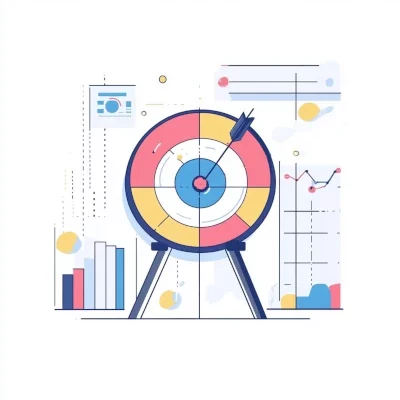When to use top-down targets and when to use bottom-up targets
As business transformation leaders, we’re often faced with the challenge of setting goals that drive real change. Whether you’re looking to improve operational efficiency, enhance customer experiences, or innovate across departments, one thing is clear: the way we set and communicate those goals plays a pivotal role in the outcome.

There’s no one-size-fits-all approach to goal-setting. True transformation happens when we understand the strengths of both top-down and bottom-up approaches to goal-setting—and know when to use each.
Think of it as two-step process. Initially, you need top-down targets to drive the improvement in the overall right direction and with enough momentum to achieve the needed strategic priorities. Once you’re moving in the right direction at speed, you want to set more detailed bottom-up targets that cascade down through each area being impacted so that everyone effectively has a target they’re working to.
When the two work together, magic happens.
So, how do we find the balance? Let’s dive into the nuances of top-down and bottom-up targets, how they complement each other, and how to leverage them to drive successful, sustainable improvement across your organization.
1: Understanding the Top-Down Approach
Top-down targets are typically set by senior leadership to steer the organization toward its strategic goals. These goals are usually broad, high-level, and focused on the long-term vision of the business. They provide clarity, purpose, and alignment for the entire team, ensuring that the organization is running in the right direction..

Detailed Explanation:
Imagine you’re navigating a large ship across the open sea. The captain (your senior leadership) charts the course, ensuring that the ship stays on track to reach the ultimate destination. This is what top-down targets do. They’re like the map, the compass, and the charted path for the entire crew. Without them, your team might drift off course, losing sight of the broader business goals.
Top-down targets are often tied to organizational priorities, such as increasing market share, boosting revenue, improving customer satisfaction, or enhancing operational efficiency. They serve as clear markers, allowing leaders to communicate a unified vision across all levels of the organization. By setting these goals, leadership provides focus and direction, helping employees understand not just what they’re working on, but why it matters in the grand scheme of things.
But, while the top-down approach sets the stage, it doesn’t always capture the nuances or realities at all levels of the organization. That’s where a balance comes in.
Questions to Consider:
- How can you ensure that the top-down targets are clearly communicated across all levels of the organization?
- How can you make sure these high-level goals resonate with employees who might not see the connection between their daily tasks and the overarching mission?
- What steps can you take to ensure these targets remain flexible enough to adapt to unforeseen challenges or opportunities?
Example:
In a global resources company we worked with, senior leadership set ambitious top-down goals for a transformation aimed at significantly increasing volume and reducing unit cost. The goals were based on a high-level diagnostic of what was potentially possible and were in direct response to recent major reductions in the price of ore. The goals set the stage for detailed work across the company which would provide the suite of initiatives that would eventually deliver the overall target volume increase and unit cost reduction. This process not only clarified the “why” but also boosted motivation and engagement across the board.
2: Understanding the Bottom-Up Approach
Bottom-up targets are often based on real-time data, insights, and day-to-day challenges by those directly in the areas involved. They are about empowering employees at all levels to contribute ideas, identify areas for improvement, and create goals that reflect the realities on the ground.
Detailed Explanation:
Employees at the operational level are often the best positioned to identify inefficiencies, suggest improvements, and set realistic, actionable goals. This is the power of bottom-up targets. Employees at the lower levels can spot problems before they become major obstacles and help ensure that the targets set are both achievable and aligned with the reality of day-to-day operations.
When organizations leverage bottom-up targets, they can encourage a culture of collaboration and improvement. Rather than simply being told what to do, employees are actively involved in the goal-setting process. This involvement not only makes the goals feel more personal and attainable, but it also fosters greater ownership and accountability across the workforce.
Questions to Consider:
- How can you encourage employees to take ownership of setting their own targets without overwhelming them with too much responsibility?
- What steps can you take to ensure that bottom-up goals align with the company’s broader strategic vision?
- How can you gather feedback from employees in a way that is structured yet flexible, ensuring their insights are captured and acted upon?
Example:
At the same resource company, we referenced earlier, the bottom-up targets were set after the detailed initiatives were defined during the transformation.
The bottom-up targets were essentially a consolidation of the expected savings from all the initiatives defined. The bottom-up targets weren’t fully solidified until all the implementation planning had been completed for these initiatives. This included defining the current/future state of each initiative, the estimated costs and savings and a detailed work plan to achieve the proposed future state including when the benefits would be delivered for that initiative.
The bottom-up target was essentially defined by every initiative owner involved in the Transformation and the detail provided a target that allowed the team to time bound the expected improvements month by month. This bottom-up target then became the defining target that the entire company worked towards delivering during implementation.
3: The Power of Balancing Both Approaches
When top-down and bottom-up targets are balanced correctly, they create a powerful synergy. Senior leaders provide the vision and high-level direction, while the rest of the organization bring real-world insights and execution capabilities. The result is a more engaged workforce that is aligned with the company’s strategic goals but empowered to contribute to them in meaningful ways.
Detailed Explanation:
This is why combining top-down and bottom-up approaches is so critical in driving improvement. When both are in harmony, you get the best of both worlds: direction and innovation. Leaders provide the overall framework, ensuring the business is moving toward a common goal, while the rest of the organization actively contribute to how that goal is achieved, making it more practical, actionable, and relevant to the day-to-day work.
For example, senior leadership might set a top-down goal of increasing customer satisfaction by 20%. But it’s the employees working directly with customers who can provide the insights on how to reach that goal—whether it’s streamlining processes, improving product features, or enhancing communication. By allowing both sides to contribute, you create a holistic, well-rounded approach that is more likely to succeed.
Questions to Consider:
- How can you create a system where both top-down and bottom-up contributions are valued equally?
- How can you ensure that bottom-up feedback is taken seriously without compromising the broader strategic goals and actually builds towards the top-down goals?
- What methods can you use to track progress from both top-down and bottom-up initiatives to ensure alignment?
Conclusion:
In transformation and continuous improvement, goal-setting isn’t just about dictating a course of action from the top or getting employee feedback from the ground up—it’s about finding the balance between the two. Top-down targets provide clarity and alignment towards the required strategic priorities, while bottom-up targets empower the rest of the organization to take ownership and provide the detail to make those top-down targets a reality. When combined, they form the backbone of an engaged, motivated, and high-performing organization.
By understanding when and how to use both approaches, you can ensure that your improvement efforts are not only effective but sustainable. So, as you embark on your next transformation initiative, remember that a collaborative, well-rounded approach to goal-setting will make all the difference. The best transformations happen when every voice is heard, and every team member is aligned toward a common vision.
